TON and Digital Resistance

When it comes to the hottest public chain in 2024, TON (The Open Network, formerly known as Telegram Open Network) definitely has a place. As a high-performance Layer1 closely related to Telegram, with over 900 million monthly active users, TON has gained favor in the capital market. According to the TON ecosystem research report released by LongHash Ventures, TON's on-chain metrics have experienced explosive growth in the past six months: the daily active users on the TON blockchain have increased from 200,000 to 500,000, and the number of wallets has surged from less than 10 million to over 44 million.
In addition, with the integration of Tether and TON in April 2024, it has created over 700 million US dollars in liquidity, surpassing Near to become the fifth largest blockchain in terms of USDT issuance, second only to Tron, Ethereum, Avalanche, and Solana. Meanwhile, on April 10th, the price of $TON surged by over 25%, reaching 7u, and its market value reached 23.7 billion US dollars, surpassing $ADA to become the tenth largest cryptocurrency by market value.
Binance also listed $TON on August 9, 2024, and unexpectedly announced the launch of new coin mining for TON on the 13th, becoming the first project to be listed on Binance for new coin mining after circulation, and currently the largest project by market value listed on Binance.
However, on August 25th, Pavel Durov, the CEO of Telegram, was arrested by the French police in Paris, accused of failing to control Telegram and allowing illegal activities such as terrorism, money laundering, and drug trafficking to spread. Due to the close relationship between TON and Telegram, Coingecko data shows that the price of $TON fell by over 14% within 24 hours, and DefiLlama data shows that TON's ecosystem TVL fell by over 40% within 24 hours.
Following the event, heavyweight figures in the technology and media industry, including Elon Musk and Tucker Carlson, publicly expressed their support for Pavel. The TON official account posted "Resistance." on X to show resistance, and set Pavel's hand-drawn Resistance Dog (REDO) from 2018 as the avatar.
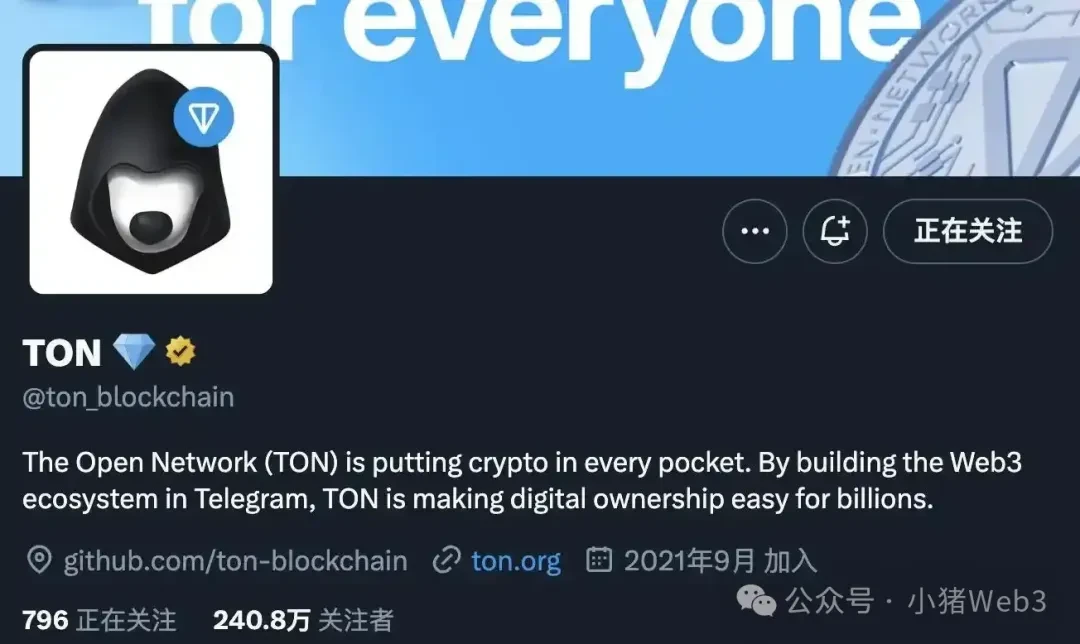
The TON community account, TON Society, not only changed its avatar but also initiated the #DigitalResistance movement on X platform.
"Today, we stand with Pavel Durov, the creator of Telegram. In support of DigitalResistance, we will update the Toncoin logo and profile pictures on the TON community channel to the global symbol of digital resistance - the resistance dog. Pavel Durov initiated this movement to fight for the privacy of Telegram users and freedom of speech."
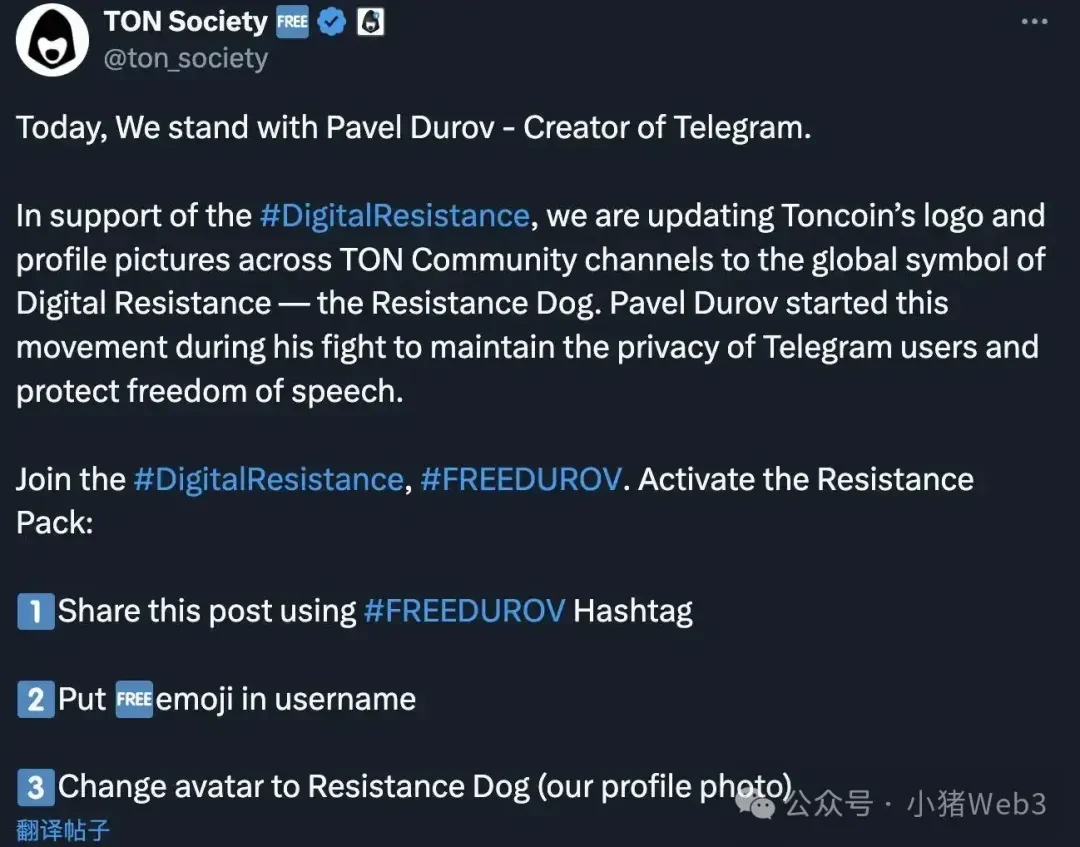
It is worth noting that the official Binance page shows that TON's logo has also been updated to the Resistance Dog. A resistance movement facing destiny is unfolding in the digital world beyond "Black Myth."
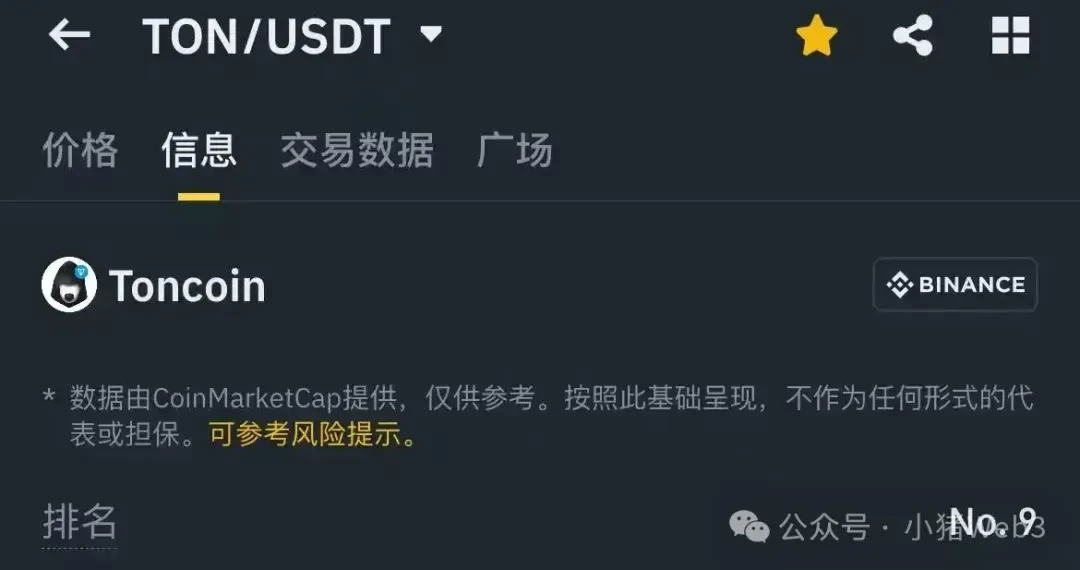
The Story of TON
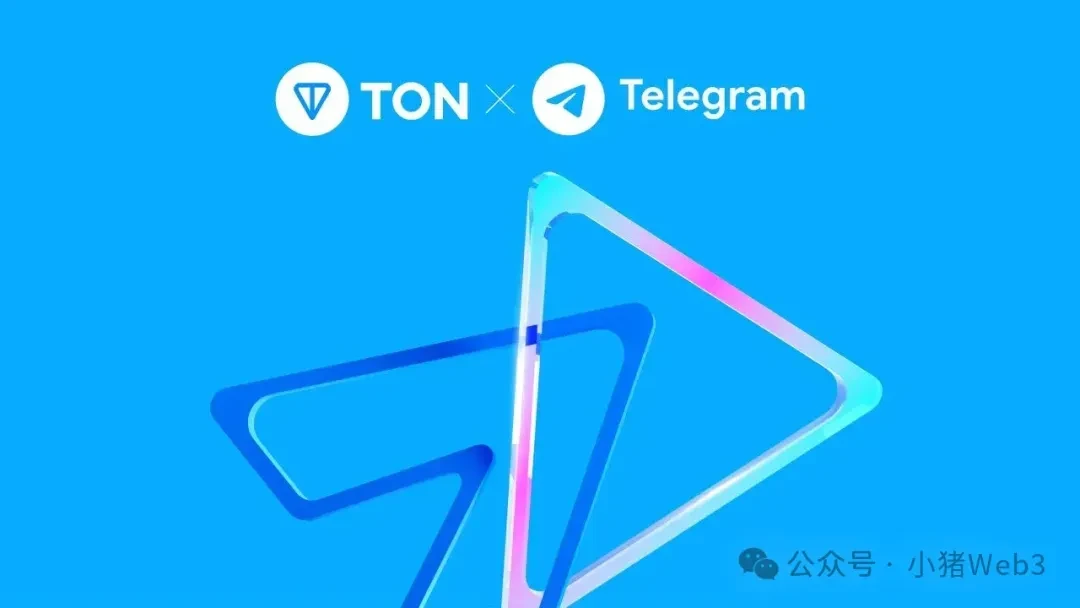
The story of TON is full of entanglement between human affairs and destiny. Looking back at the development of TON, it is impossible to bypass Telegram. Telegram was founded by the Russian brothers Pavel Durov and Nikolai Durov in 2013, aiming to provide a more secure and private instant messaging platform.
Here's a brief introduction to Telegram's encryption technology - the MTProto protocol. The protocol is designed for speed and security, supports end-to-end encryption, and ensures that only the two parties in a conversation can read the message content. Although all Telegram messages are encrypted and stored on servers, users can choose to use the "secret chat" feature with end-to-end encryption for specific conversations, meaning that no third party, including Telegram servers, can read the chat content.
With its high level of security and user experience, Telegram quickly grew to become one of the world's leading communication platforms, with nearly 900 million monthly active users, and became an important tool for the Web3 community.
In 2017, in response to the security and privacy needs of Telegram's massive user base, the Durov brothers began developing a blockchain project called the Telegram Open Network (TON) and planned to launch its native cryptocurrency, Gram.
In 2018, Telegram raised approximately $1.7 billion through an ICO, making it one of the largest token issuances at the time. Investors included several large venture capital firms and individual investors, and the ICO also attracted the attention of the SEC.
In October 2019, the SEC accused Telegram of conducting an unregistered securities offering. This legal challenge greatly hindered the progress of the TON project. After long-term communication and legal battles with the SEC, Telegram announced in May 2020 that it was withdrawing from the TON project and handing over the development work to an independent open-source developer community. The project was renamed "The Open Network," and the token name was changed to Toncoin. The ICO funds were refunded.
In 2021, the TON Foundation, founded by Anatoliy Makosov and Kirill Emelianenko, took over the project and continued to move towards decentralization and scalability.
In 2023, the Telegram official announced that the TON blockchain would be the preferred infrastructure for its Web3 and integrated it into the user interface of the Telegram application this year. $TON is also used for all transactions and payment activities with channel owners, making it the "platform coin" of Telegram in a practical sense.
TON's Economic Model, Core Technology, and Ecosystem Narrative
TON's core design concept is to reconstruct traditional blockchain protocols in a "bottom-up" manner, pursuing ultimate performance and scalability, and is expected to support 30% of Telegram users in the future. With its unique design concept, high-performance performance, and the traffic empowerment of Telegram, TON has attracted a large number of users and investors' attention. This article briefly summarizes its economic model, core technology, and ecosystem narrative.
Economic Model
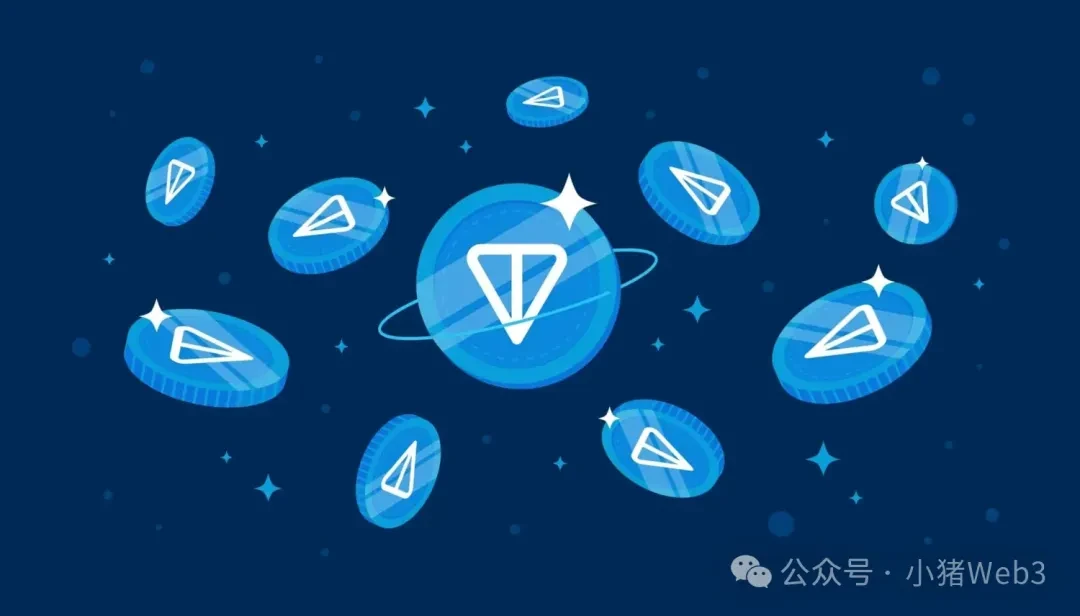
$TON has an initial total supply of 5 billion tokens. In terms of token distribution, the team initially holds 1.45% of the tokens, with the remaining 98.55% being mined through PoW in the early stages.
Mining on TON started spontaneously and randomly. Due to the litigation between the Telegram team and the SEC ending in a settlement in 2020, work on TON was forced to stop. In order to exit the TON project but allow enthusiasts to explore the technology, the Telegram team placed all blockchain tokens into smart contracts, allowing anyone to mine them equally.
As the distribution of tokens through PoW smart contracts was exhausted, traditional TON mining ended. TON entered the PoS stage, adding more validators and tokens for validation to enhance network stability and security. Validators can earn new $TON as rewards for participating in network operations, with an annual inflation rate of 0.6%. Currently, approximately 650 million $TON is staked.
The current total supply of $TON is approximately 5.1 billion tokens. However, due to the TON Foundation freezing around 1.1 billion inactive mining wallets and the TON Believers Fund locking around 1.3 billion $TON (scheduled to unlock from October 2025), the circulating supply is less than 2.7 billion tokens.
In addition to serving as the Gas token and staking token on the TON network, $TON can also be used on Telegram as a "token pool" to enhance its value. For example, Telegram recently announced that it will exclusively use $TON for advertising payments. In this setup, advertisers use $TON to fund their marketing activities, with revenue being evenly split between Telegram and content creators. Furthermore, Telegram has started accepting $TON for payment of Telegram Premium, a service provided by Fragment Store with 5 million subscribers. These initiatives demonstrate the Telegram team's efforts to ensure that $TON is a token with practical utility and a clear mechanism for value accumulation.
Core Technology
The most core technology of TON is its Infinite Sharding Paradigm, which greatly enhances the processing capacity and scalability of the TON network.
Sharding is a scaling solution under the trilemma of scalability, and its basic idea is to divide the entire blockchain network into multiple smaller segments (shards), each of which can independently process a portion of transactions and data. By dispersing transactions and data to different shards, the sharding mechanism can increase the throughput and performance of the entire network, similar to how opening multiple checkout lanes at a supermarket can intuitively reduce waiting times and improve checkout efficiency. Well-known sharding chains besides TON include Near, Harmony, Elrond, and others.
TON's sharding architecture is divided into three layers: Masterchain, Workchain, and Shardchain. Masterchain is unique and responsible for coordination; Workchain is a virtual concept that exists as a collection of Shardchains, with the system able to accommodate up to 2^32 Workchains; Shardchain is responsible for actual transaction processing and is dynamic, automatically splitting when the load increases and merging when the load decreases, with each Workchain able to split into up to 2^60 Shardchains.
To address communication between sharding chains, TON uses smart contracts based on the Actor model and selects FunC as the primary contract programming language. In TON, each instance of a smart contract has an address, code, and data unit (persistent state), and smart contracts always have atomic synchronous access to all their persistent states. However, communication between instances of smart contracts is neither atomic nor synchronous, which is a significant difference from the development paradigm of other smart contract chains (such as Ethereum, Solana), and has led to difficulties and slow development of DeFi on TON.
If you are familiar with the microservices architecture of Web2, you can simply compare the smart contracts on TON to microservices, and the entire Infinite Sharding Paradigm of TON to Kubernetes' elastic orchestration service - creating new contract instances and dynamically scaling, shrinking, and moving them as needed to optimize the system.
Ecosystem Narrative
The TON ecosystem currently has over 500 Dapps, covering various fields including infrastructure, development tools, DeFi, GameFi, SocialFi, NFT, memes, inscriptions, and almost all popular directions.
However, the true narrative of the TON ecosystem lies in Telegram's Web3 landscape, mainly including Telegram Bots and Telegram Mini Apps (TMA).
Telegram Bots are automated tools running on Telegram that can respond to messages, manage data, or interact with users programmatically. Developers can create bots to perform various tasks, such as sending notifications, providing information services, or even handling complex commands. Users interact with bots through conversations to achieve automated functions. Currently, Telegram Bots play an important role in Web3 community building, asset management, information aggregation, project promotion, and DeFi transactions, among other areas.
TMA is a web application running within Telegram Messenger, launched by the TON Foundation to meet user needs for games, content sharing, productivity tools, and more, easily accessible from Telegram chats or group conversations. Among them, @Wallet is Telegram's built-in non-custodial wallet TMA, similar to MetaMask, allowing users to receive, send, and exchange tokens, and the wallet page displays NFT assets held by the wallet.
The organic integration of @Wallet, Telegram Bots/TMA, and TON provides Telegram users with a complete closed-loop Web3 experience: from receiving messages and communicating in Telegram groups/channels, to conducting token transactions and DApp interactions on TON through Telegram Bots/TMA, and then participating in TON ecosystem projects using @Wallet and TON Space.
In conclusion, TON has experienced numerous challenges and setbacks, from its highly anticipated launch to being sued by the SEC, and finally being taken over by the community and growing. Backed by Telegram's 900 million monthly active users, TON has user traffic that is difficult for any other public chain project to match. Its Infinite Sharding technology theoretically supports millions of TPS, and its integration with Telegram provides a unique opportunity for large-scale adoption of Web3. The rapid growth of on-chain metrics, strong support from top-tier capital, and the success of various ecosystem projects highlight its potential.
Pavel created Telegram, known for its censorship-resistant strong encryption, and also created the symbol of the spirit of resistance, REDO. TON seems to have established itself as the heir to Pavel's spirit of resistance, modifying the community avatar and logo to REDO, and launching the DigitalResistance manifesto as if to "face destiny head-on."
免责声明:本文章仅代表作者个人观点,不代表本平台的立场和观点。本文章仅供信息分享,不构成对任何人的任何投资建议。用户与作者之间的任何争议,与本平台无关。如网页中刊载的文章或图片涉及侵权,请提供相关的权利证明和身份证明发送邮件到support@aicoin.com,本平台相关工作人员将会进行核查。




